Genre: Racing Developer: Tiertex Publisher: Sega Enterprises Players: 1 Released: 1992
To say that AM2 and Sega caught lightning in a bottle with the original arcade OutRun is not an exaggeration. The game is definitely one of the company’s classic titles, and those who have played the deluxe cabinet know why arcades used to rule. This was a game that took all your quarters, lunch money, rent money – everything. It was that good.
Anyone who even remotely likes Sega has to be an OutRun fan. Seriously, it’s written in the Bible, the Magna Carta, and the Constitution – you simply cannot profess to say you’re a Sega fan unless you enjoy dashing around in a convertible Ferrari with a hot girl by your side. OutRun embodies that classic sense of freedom of the road, the feeling that anything is possible when you’re behind the wheel of an incredibly powerful machine, the open highway ahead of you and absolutely no speed limits for as far as the eye can see.
When the sequel, Turbo OutRun, was released in 1989, some people felt that it lacked the charm and polish of the original. The turbo button mixed up the gameplay, and the ability to upgrade the Ferrari was seen as an interruption to the sense of speed and flow the series had become known for. Naturally, both of these elements were integral to the Mega Drive port (the game was never released in the U.S.), but things seem to have been filtered down even further during the transition to Sega’s wonder box.
First and foremost is the hit the scaling has taken. I know that the good ol’ MD can’t simulate anything along the lines of the Super Scaler technology seen in arcades, but the original OutRun on Genesis did a pretty good job of providing a smooth experience. Turbo OutRun fails completely in this regard and looks far choppier than its predecessor. The visuals are crisp but undetailed, with much of the arcade version’s background elements removed, and the overall presentation suffers greatly from the poor scaling. This is unforgivable, in my opinion, and it steps all over what is one of the franchise’s calling cards. How can I feel immersed if things are so rough?
Even worse, the vaunted turbo button does absolutely nothing to fix this. Press the button, and the player gets a nice Batmobile-like flame from the back of the car, but that’s about it. As with the original, the more the button is pressed the higher the temperature raises, until “OVERHEAT!” flashes on the screen. After some time to cool down, the feature can be used again, though it doesn’t really add much. The coin-op sped things up when turbo was used so that it not only gave the impression of increased speed, but it also made steering harder on curves. On the Mega Drive, control is hardly affected (it’s not all that good to begin with), and a simple tap of the brake negates the boost entirely. Now, I’m no physics professor, but I would think that it would take a bit more to slow me down after I’ve doubled my speed, especially on a turn. Of course, if something should stop me, I can always just tap the turbo button again and be back up to my original speed in no time, with no lingering effects from whatever it was that hit me.
That’s what really angers me about Turbo OutRun. The turbo element should be regarded much like the hyperspace button in Asteroids: it’s there if you need it, but it’s not always a safe route to take. Launching my car into hyperspace just before a steep curve should not mean a clean getaway. I should be as wary of tapping that button as I am of the actual obstacle before me, but somehow Turbo OutRun never makes me worry about abusing the nitro.
So the very element that gives this installment its name is a bust. That should be bad enough, but there’s more. Unlike the first game, Turbo OutRun offers more than just traffic to keep players from achieving the next location. The awesome branching paths of the first game are gone, and it’s always the same route now every time. However, there are now obstacles scattered along the road, from tumbleweeds to barrels, and it’s possible to rocket into a turn only to be stopped cold by something laying right on the highway. The police are also out in force, despite the afore-mentioned lack of speed limits. Putting these things in the player’s way would seem like a good idea, if they posed an actual threat. The turbo button can be used to escape Johnny Law, and the obstacles themselves can easily be avoided in most cases. Together, the two features come off as poorly thought out, and they end up being continual annoyances, rather than actual detriments. Perhaps the biggest threat comes from the weather, which can worsen the already ailing controls. Snow and rain do little to hinder visibility, but they can make a course almost impossible by making the car slide uncontrollably.
Should the player actually complete four stages in a row, the Ferrari can be upgraded. The engine and tires can be enhanced, as can the turbo feature. None of them enhance the gameplay, unfortunately, and the car still slips and slides all over the place. This not only affects performance, but also the player’s manhood! Turbo OutRun introduces a rival to the gameplay who tries to get in the player’s way. Adding insult to injury, he’ll also take the Ferrari-loving lady friend away should he get to the next upgrade checkpoint first. It’s as if Turbo OutRun is deliberately trying to get into one’s brain, as though a mere “game over” screen isn’t enough to hurt those who dare play it. No, Turbo OutRun want to emasculate you as well.
And much like a cheap porn flick from the ’70s, it does this without any regard for atmosphere. In addition to the choppy scaling, the soundtrack is also quite a few notches below the classic tunes of the first game, and the in-game sounds grate after a short time. There are more songs than before, but the quality is worse and none of them are at all memorable.
In the grand scheme of things, most people will regard Turbo OutRun was a brain fart, a game that got a port because it had to. I look at it (along with Data East’s subpar OutRunners) and see lost potential. The OutRun series was always great in the arcades, and each subsequent port on the Genesis was worse than the one before it. The only consolation fans have is the first game, which seems to be the only time Sega got it right.
SCORE: 4 out of 10

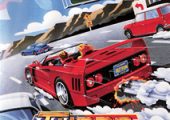
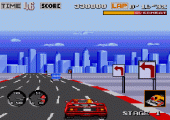
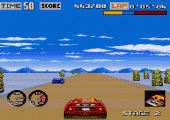
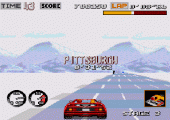
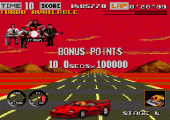
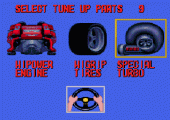
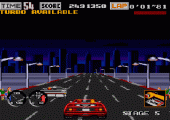
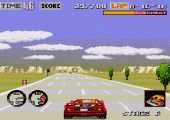
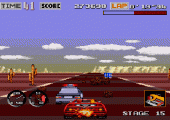
Recent Comments